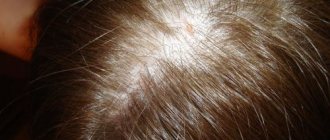Causes
The most common reason is habit. A person twirls his hair at a moment of thoughtfulness, awareness of some problem, or prolonged reflection. This simple action helps you concentrate on your thoughts and stop reacting to external stimuli.
Other reasons are presented below.
- The desire to calm down. The sensation of twisting your hair is reminiscent of a soothing pat on the head or a relaxing massage. That's why children of preschool and primary school age can use this relaxation method. Sometimes it’s easier to cope with separation from your mother.
- Fall asleep faster. The baby plays with his hair when he falls asleep. Gradually he falls asleep without the help of his parents. Usually this bad habit is eradicated with age.
- The desire to escape from your problems. As a child gets older, the number of stressful situations increases. The habit of touching hair develops into a compulsive action. A vicious circle is formed: he gets a little nervous - he twirls his hair - he realizes that this is bad - he gets nervous.
- Another reason is a feeling of defenselessness. Being very frightened, the baby decides to pull his hair. He thinks that this will make the situation safer and help get rid of obsessive fear.
- It happens that he begins to pull not only his own hair, but also other people’s. This is how a child often hurts his mother without even realizing it. Sometimes he uses his fingernails, literally tearing out entire clumps of hair. And there is only one explanation for this - he is scared and wants his parent to protect him from everyone.
Symptoms
The compulsive action is so important that the inability to perform it is perceived as a threat to life. The need to constantly pull your hair occurs in stressful situations and is repeated. This may also be a reaction to chronic stress that the child cannot eliminate from his life (parental quarrels, peer bullying, problems at school).
If an uncontrollable action is interrupted, the child will do his best to look for a way to complete it: he will begin to twirl his hair a certain number of times or in some sequence. The baby will do this until he calms down completely.
Consequences
Any neurosis that is not diagnosed and treated in a timely manner significantly harms the child. The psyche at this age (preschool and primary school) is still fully formed, and the nervous system is unstable.
A lot of physical and mental energy is spent on compulsive action and thoughts about it. As a result, obsessive curling of curls in children can lead to the following consequences:
- decreased capabilities of all cognitive processes (memory, attention, thinking);
- the child gets tired quickly and is unable to concentrate on lessons;
- sleep disorders, nightmares;
- lack of contact with other children (he does not play, does not make friends with them, because they can tease him);
- general isolation, lack of contact with adults.
Hair follicles suffer from constant tension. As a result, the hair breaks, becomes dry, lifeless and falls out. In damaged areas, curls may not grow back well for the rest of your life.
The worst thing is if the baby starts pulling out hair on his head.
This occurs when a child begins to twirl their hair around their thumb. This habit can eventually develop into trichotillomania. This is a type of auto-aggression when, in order to calm down, a person pulls out individual hairs or even tufts of hair on the body. In neglected situations, bald patches form. In such a situation it is no longer possible to cope without the help of a psychiatrist.
The habit of twirling hair on a finger among teenagers
- For growing children, the habit of twirling their hair on their fingers can have two meanings. Obsessive contact with hair may indicate a mental disorder. In this case, you cannot do without the help of a psychotherapist.
- Timely attention to this problem will help to avoid serious consequences in the future.
- During the process of physiological changes, adolescents find it difficult to accept some changes. Constant contact with hair is a reflection of childhood insecurity, complexes, and a critical attitude towards one’s appearance.
Teenagers
- Such manifestations can be minimized with the help of handicraft sections or sports clubs. An active daily routine will leave no time for unnecessary thoughts. The daily routine relieves excess stress and stimulates the nervous system to overcome ailments.
- Girls can use twirling their hair around their fingers as a way to flirt with the opposite sex. With such gestures they try to attract additional attention and add mystery to their image.
Self-medication
Helping a child or even an adult on your own is possible. Especially if a girl or teenager suffers from this bad habit.
Some of the simplest but most effective methods are:
- creating beautiful hairstyles;
- braiding;
- beautiful hair curling;
- gentle and neat styling;
- short haircut (if it suits your face), etc.
The girl needs to be explained that pulling her hair is an indicator of her excitement and worry. That this does not always look attractive, and characterizes a person as nervous. It is necessary to delicately and very carefully explain to her that such similar actions make her image one-sided and demonstrate her as a complex, insecure person.
Some doctors advise patients to take up handicrafts. Hands will always be busy, and a person will have no time for curling curls. If the activity is really exciting, then getting rid of the problem will be easy.
How to stop a child from biting his nails and sucking his fingers?
- Try to determine the original cause of the stress and tension that is oppressing your baby, and then try to eliminate it. Perhaps you yourself are too nervous and the baby is only copying your actions. Either you are too harsh and demanding in your relationship with him, or you punished him very severely.
Relationships with other family members, other children or peers probably require adjustment. Thousands of various events of the day could excite the child, cause him irritation, but he did not have the opportunity to relieve his soul. We need to try to relieve this nervous tension and add peace, fun and joy to his life.
- If the habit is already established, observe when it occurs less and when it occurs more. If the habit of biting nails is especially common when watching television, you can reduce the time the child spends in front of the TV, replace watching with a trip to the cinema, etc. The main thing is to change the situation , not the child’s behavior.
- Replace a bad habit with a healthy one . It is useful to keep the child's hands busy - with modeling, drawing, toys, etc. For example, you can offer to engage in some other activity while watching TV: knitting, embroidering, sculpting, drawing, sorting through small toys, gnawing vegetables (carrots), etc. The main thing is to keep your hands busy!
- Teach your child to relax and relieve tension - physical activity during the day significantly reduces the level of nervous tension. Walk more often, visit the pool, devote time to health and proper nutrition.
- Try not to overstimulate yourself or your child during the day. At night, it is best for the baby to take a bath with salt or a soothing mixture, give a light relaxing massage and give the maximum possible amount of physical contact.
- Speak kind words to your child, praise him for the slightest achievement, be attentive and tolerant towards your child.
Treatment options
The first step on the path to recovery is a consultation with a psychologist. It helps to find out the reasons for the development of such a habit. It will explain whether it is an addiction or just an alarming symptom.
If it's just a habit, a behavioral approach will do. In psychology, this is one of the methods of behavior management. You need to make sure that curling your hair leads to unpleasant consequences (not to punishment, but to not getting what you want). A short haircut helps, but only with the consent of the child.
If we are talking about compulsive actions or auto-aggression, you need to perform the following steps.
- Continue working with a psychologist until complete recovery or a significant reduction in the severity of symptoms.
- Drug treatment can be included.
- It is important to follow a daily routine. Do certain things on a clear schedule day after day (sleep, eat, walk). This routine is calming, because you know in advance what will happen and when. The nervous system receives a resource to overcome the disease.
Development occurs from a “point of rest,” that is, at a time when there are no shocks in life.
When curling your hair, there is no need to pull it back or make comments. This will push your child away from you and cause him to hide.
Calmly ask what is bothering the child. Try to discuss everything and show another way to calm down. The best thing to do is to hug him and tell him that he is the most wonderful and loved one.
Use your example to show how you can deal with anxiety, anger and irritation constructively. Not by swearing and screaming, but by expressing your emotions in the form of “I” messages. Phrases used in the process:
“I’m upset because...”; “I’m offended because...”; “I’m very glad, because...”, etc. Talk about feelings on your own behalf, meaning the baby’s experiences. The child must understand that he is not alone, he has support.
The most difficult thing in psychotherapy is to find out that parents themselves provoke the formation of stress. You need to be prepared for this, do everything in the interests of the family member.
During the period of therapy, there should be no scandals, major holidays, moves, or changes of schools in the family. Stress, both positive and negative, is detrimental in such situations.
Cognitive behavioral therapy
This technique is effective in relation to both an adult and a child. The goal of cognitive behavioral therapy is to change the patient's negative attitude to a positive one. As a result, he should understand that he can calm down or get out of a state of stress without curling his hair.
At the beginning of the first session, the psychologist must find out the reasons for the development of OCD. To do this, he asks the client to share thoughts about the following:
- does he feel better from tugging at his curls?
- how he feels when he pulls his hair;
- does this action bring him pleasure, peace and tranquility;
- what will happen if he stops doing this;
- does he understand the consequences of this bad habit, etc.
In addition to an individual conversation, the patient must do homework. The speed of healing depends on the quality of their execution. They mean studying materials about the dangers of pulling hair: watching video lectures, reading specialized literature, communicating with trichologists.
The average duration of treatment is 5-6 sessions. They last 40-60 minutes and take place once a week. If the habit has already reached the stage of mental dependence, then the duration of the course can be 10 lessons.
Calendar for Today
Birthdays: Mouse-Norushka Irochka (42) fawn (36) lezdeika (36) Violika (38) shellest (33) Ksysha0810 (35) myshulya11 (36) Maximilian (35) Anastasi__ (37) dakota888 (42) Radnad (42) radiys (39) Lil mam (37) Milana_86 (34) aksinya (37) Irina Shanaykova (41) Coloring (40) mersasha (41) Poelina (41) lenka00 (35) Alesya Byvalkevich (41) kotofei (38) LIZZA (38) ) Larisa Stepanova (39) Vitaliyamama (37) krasotka261 (37) ahahacik (31) Govorusha (36) jus14 (38) Macycance (32) apello (43) vik_mik (32) nikolai (42) Lelya25 (34) Tofstoolffoep (34) WeegefMot (31) KerUrgetteBug (35) Fuscoumputect (32) AxopekS (31) inwacewed (31) chokyToonry (35) zedimmutt ) Roffaumnvum (31) OliVKa261111 (28) Tikana (28) gliness (49) xlogicc (49) gerecreaphiva ( 43) VErVessispDop (34) Aspork (37) Unfancase (34) Apponfouh (35) SnoraminYramy (41) Stealipep ) Avandabaw (35) Betextept 32 ArgutsJug (45) varenikov (40) photoSots (33) MamaKostika (46) Vadvathetle (38) CledaSpamebem (45) Fluffenny (42) arodiubdito (38) Marffaurfphes ( 35) Smuplemotem (40) fekPlenoleHex (45) mipEmillemero ( 45 ) masyanechka1985 ( 35) vera87 (33) Vustisuatepsy (35) taxitodaybusine (42) Lonryunum ( 35) MUGMAYOMY (35) Fermentsor (32) excelf (38) swarnelurnark (35) Favopsannoush (43) crurgyalago (35) equaniembebra (37) Alenka M (37) АslanbekTT (32) genericos (37) anya512 (33) Outsipini (34) ) Cheemimmoni (37) Atlantic (38) infatothonsox (43) AlexDeri (37) greyderj (34) Bigsdoom (32) Acomsjonse (41) gribochki2003 (39) EnromomeNound (32) speancycleave (32) dvdvids (33) isominodo (37) affone (33) irina_ven (32) smoopAmishRok (33) Roongitte (33) Waltonoweanty (44) Prexenribra (34) Armanico (34) Weanlilla (44) exalgeanaenly (35) Illildgus (41) TrierneWeft (37) nipsylic (33) Caxindina (37) ) neexwresise (38) bymnaliennady (37) angelok25 (33) Smalpeemi (33) Turoff (41) Nefzoroff (33) mumnZeltMeamn (33) bluesywrososy (34) dvg_s (49) gukniol (45) racergame (33) Holoanaerligo (38) fluonnabene (41) Fopuhrergeono (34) AByncencaraNal (34) AseergeDeali (37) Pottelodeerge (35) Alinab (44) bartonass (32) boolleyOwer (43) Ansseluf ( Ansvelgw 35) Ansrelua (33) Laxthella (40) vladitetmo (32 ) Bviaziless (44) senticybits (33) riutoread (45) Antbelvw (41) temagomma (45) Hauptplussy (33) usecouscugh (41) entisaSit (33) DuseunivaDial (44) Charlesa (34) EretleSlike (33) ownelvemonI (33) ATheothIdeossy (35) Paudiobia (34) Bymnnasyalups (44) optiggine (33) trauttyMowBaw (33) Enundaqualm (35) fibbaduaw (34) prostosi (42) Alexiymug (33) bignevage 43) Avatriart (43) dionnorgo (36) loariagrirm (40 ) tapefiple (43) Goipomiun (35) Speelpima (36) Jourlsturimus (33) empopsplete (43) Irinka Vetrova (39) etetsEvetly (38) exodymnendaro (37) embathePairee (40) pierdos8 (34) SoornomCreers (45) Unpandaassism (44) CarltonGah (36) Felisheatte (45) groocheKneene (35) Irogleff (37) Ablubdiply (43) Forrojert (38) Drierscew (40) Eskilep (32) Foemnelomeery (44) TimothyMn (34) TiptThatTom (39) SnawsSymnnalf (33) Serzilas ( 36) ClaytonMa (32) Walariviavy (43) Nurreta (39) CurryDom (36) Geldsund (36) ManuelSilk (34 Laulley (38) AssiniaKili (38) aeroplebleade (37) Hermanki (34) upseskdap (40) Svetlana85 (35) Bradleydium (42) Vulzoris (32) DennisCeno (38) Jeremyrure (33) aliherJUG (34) Dennisplor (41) Belectrq (41) joroure (45) bobomign (33) sporces (41) credits (42) DelmerMem (34) agodayDom ( 44) TojyPaype (45) DifaPaype (45) Jaxexekly (40) MewCrone (43) AAdderscedo (32) Aavaifasy (44) AAttervetax (41) Anthonyfuh (33) Vinniepr (41) Muardalato (35) ElapMubs (32) Iuzealato (45) Georgebout (36) RozDaf (38) MobigeNof (34) MiltonEn (38) ZewatrToca (44) Mumdigin (41) Virtuchi (42) Charlescype (39) Edwardnell (45) galinashulzhik (40) HowardSa (36) CherlesMew (35) gruzoperevozkipomoscvebup ( 42) Alurlappolo (32) Sportuly (35) Alenkabeme (40) novotehLymn (39) Patrickvate (33) Eugeneon (37) Bratuxas ) Ashleyma (35) Valizoon (43) Lennoknend (38) Jeffreydeby (34) Aziza22 (33) elena-k32 (38) LifersPn (40) StevenHig (44) EvanyEl (42) Rthurvany (40) LeonardWew (32) alygunJUG (42) OlgaVely (56) Koqumass (40) Denishigh (32) Reginahot (35) Thurmanhons (39) Philipmomi (39) Michaeldit (39) Haroldvuh (39) ThomasRiz (39) Eugenebog (39) Karapuzik07ceM (38) Johnnypl (44) Thomaspeirnoni (41) iohgfbOl (40) MichaelVark (38) Michaeltece (38) CovEl (40) WebsecuryEi ( 39) Saguqvty (32) Kennethmipt (36) ashketow (43) JosephNaw (40) mzotjPa (40) Znaykapi (32) Natalya Mikhailovna (37) Lwjcqroz (39) gunstreetgirl (34) Anneta_FLY (36) DRC Lion Cub (2) Natalya Sysoeva (46) Robertroano (44) Stanleynug (38) [show all]
Forum statistics
1644690 Messages in 24920 Topics from 274331 Users. Last user: Polina Lis Last message: “Re: Arbor MC “Eva”” (Today at 15:27) Latest messages on the forum. [Detailed statistics]
Online users
Currently on the site online: 1840 Guests and 6 Users. Maximum online today: 4366 . All-time maximum: 21257 (08/14/2020 at 11:50).
Group therapy
This technique is not used with children, only with adults. The group usually consists of 10 people who are united either by common symptoms or by a common reason for the development of this bad habit.
All participants sit in a circle and begin to share their stories. This is the stage of acquaintance, the purpose of which is to position all patients towards each other in order to build constructive dialogues, because sometimes people with the habit of pulling their hair are antisocial.
Role-playing games may be carried out. The most popular is wish fulfillment if one of the patients starts doing these obsessive actions again.
Lectures are also provided during group classes. Their goal is to show a person that the habit of pulling one’s hair does not bring anything good, and it is better to get rid of it.
Group classes in various types of physical activity are possible: yoga, meditation, aerobics. The conversation participants also attend cultural events and communicate a lot with trichologists.
Hair care: five useful tips
1. Frequently washing your hair will worsen its condition, so try to wash your hair at least every other day, not every day.
2. Blow-dry your hair only when necessary, and whenever possible, try to dry your hair naturally, that is, simply in the open air.
3. Use shampoos and conditioners according to your hair type. Do not apply shampoo directly to your hair, first pour the shampoo into your hand and dilute it a little with water.
4. Every evening, before going to bed, comb your hair in different directions. Wet hair should not be combed; it should be at least slightly dry. For long hair, start combing from the ends, moving towards the roots.
5. Visit your hairdresser monthly and trim the ends by 1 - 1.5 cm.
For more useful tips on how to make your hair beautiful, read the article “Hair Care Tips.”
Art therapy
When communicating with children, such a conversation may not give the expected results, so it is easier to find out the causes and symptoms with the help of art therapy. She means depicting her problem using different types of art:
- drawing;
- theatrical action;
- singing;
- dancing;
- handicrafts, etc.
It is important to choose the activity that your baby loves most. Then he will not feel any tension when communicating with the doctor.
Visual art therapy is commonly used. The psychologist communicates with the baby, and he draws in the process. The doctor asks you to depict what is bothering him. There are no restrictions.
After this, the baby’s creation is evaluated. All lines, strokes, and ornaments are taken into account. Of particular importance is the color scheme, which makes it possible to assess the stage of the disease.
Next, the doctor asks the child to destroy his drawing in any way - tear it, trample it, wet it with water, etc. The main thing is to get rid of the image, and with it the problem.










